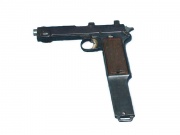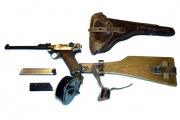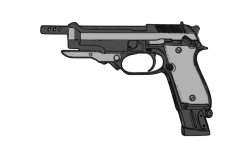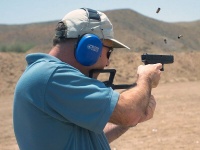Machine pistol
- This article is about full auto or burst-capable pistols. For semi-automatic pistols, see Semi-automatic pistol.
A machine pistol is a handgun-style, magazine-fed and self-loading firearm, capable of fully automatic or burst fire, and normally chambered for pistol cartridges. The term is a literal translation of Maschinenpistole, the German term for a submachine gun. While the dividing line between machine pistols and compact submachine guns is hard to draw, the term submachine gun usually refers to larger automatic firearms. Typically, a submachine gun's operating mechanism is scaled down from that of a full-sized machine gun, while a machine pistol is built up from a semi-automatic pistol design.
Machine pistols are used by tactical police units such as SWAT teams or hostage rescue teams inside buildings and other cramped spaces, who need a small, concealable weapon with a high rate of fire. In a military setting, machine pistols are issued as personal defense sidearms to paratroopers, artillery crews, helicopter crews or tank crews. They have also been used in close quarters combat (CQC) settings where a small weapon is needed (e.g. by special forces attacking buildings or tunnels).
Contents |
History and variants
1910s-1960s
The term "machine pistol" is a literal translation of Maschinenpistole, the German word for a submachine gun. In World War I, as submachine guns were found to be effective in trench warfare, experiments with converting various types of pistols to machine pistols (Reihenfeuerpistolen, literally "row-fire pistols") were conducted. The Luger P08 long barrel pistol was issued in World War I to German artillery crews. It was manufactured with a longer barrel as it was recognized that artillery crew needed a lighter weapon than a rifle but with similar accuracy to defend themselves. It had a newly developed pistol cartridge, the 9mm Parabellum, which was designed for low recoil without sacrificing penetration and stopping power. Although not armour piercing, the bullet more than sufficed for the time.
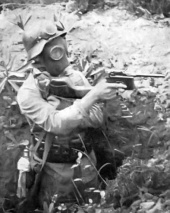
Unlike the Luger, the Mauser C96 pistol was modified to fire in a fully automatic mode. First produced in 1896 as one of the first commercially successful and practical semi-automatic pistols, Spanish gunmakers in the late 1920s introduced "select fire" copies of the C96 with detachable magazines, and in the early 1930s Mauser engineers introduced the model 711 and 712 Schnellfeuer variants, which included a fire selector mechanism allowing fully automatic fire at a rate of 1000 rounds/minute. Due to the weapon's light barrel, the fully automatic rate of fire could only be used for short bursts.
The Stechkin APS is a Russian selective-fire machine pistol introduced into the Russian army in 1951. Like the other common Russian army pistol of this era, the Makarov, the Stechkin uses a simple unlocked blow-back mechanism and the double-action trigger. In addition, the Stechkin APS has an automatic fire mode, which is selected using the safety lever. In burst or automatic fire, the pistol should be fitted with the wooden shoulder stock; otherwise, the weapon quickly becomes uncontrollable. The Stechkin was intended as a sidearm for artillery soldiers and tank crews. In reality, it earned a strong following in the ranks of political and criminal police, special forces and the such. Many KGB and GRU operatives favored APS for its power and magazine capacity. Though somewhat heavy and cumbersome, it was the only "high-powered" alternative to the modest-performing PM. As a pistol, the Stechkin APS is being slowly replaced by the Yarygin PYa; as a PDW, it was replaced by the AKS-74U compact assault rifle, now widely used in law enforcement.1970s-1980s
Since it is difficult to control machine pistols when they are fired in full automatic mode, in the 1970s, some manufacturers developed an "intermittent-fire" setting that fires a burst of three shots instead of a full-automatic stream. In the 1970s, the Italian Beretta company developed the Beretta Model 93R, a selective-fire machine pistol meant for police and military use. It offered extra firepower in a small package and is suited for concealed carry purposes such as VIP protection, or for close quarters fighting such as room-to-room searches. A selector switch and the foldable foregrip allows the pistol to fire three round bursts with each pull of the trigger for a cyclic rate of 1100 rounds per minute. The designers limited it to fixed three-round bursts to allow it to be more easily controlled.Another machine pistol that uses the three shot burst system is the Heckler & Koch VP70. It will only fire three-round bursts with the stock attached. It is a 9 mm, 18-round, double action only, semi-automatic/three-round burst capable polymer frame pistol manufactured by German arms firm Heckler & Koch GmbH; the VP designation stands for Volkspistole ("The people's pistol" literally "Folk pistol"), and the designation 70 was for the year of the first edition: 1970. It was the first polymer-framed pistol and predates the Glock 17. The stock incorporates a selector switch that allows selective fire. Cyclic rounds per minute for the three-round bursts is 2200 rpm. The VP70 uses a spring loaded striker like a Glock, instead of a conventional firing pin. It is double action only, so the trigger pull is relatively heavy. Despite the VP70's obvious potential, it was never adopted by the Bundeswehr.
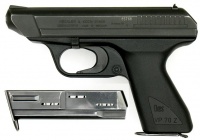
The Stechkin APS made a comeback in the late 1970s, when Russian Spetsnaz special forces units in Afghanistan used suppressor-equipped machine pistols for clandestine missions in enemy territory, such as during the Soviet war in Afghanistan.
In the 1980s, some machine pistols, such as the Glock 18 were made with vents or cuts that run across the top of the barrel. These vents act as a compensator, thus counteracting the tendency of machine pistols to rise when fired in automatic mode. The Glock 18 is a selective-fire variant of the Glock 17, developed in 1987 at the request of the Austrian counter-terrorist unit EKO Cobra. The Glock 18 is not available to the civilian market. This machine pistol-class firearm has a lever-type fire-control selector switch, installed on the left side of the slide, in the rear, serrated portion (selector lever in the bottom position for continuous fire, top setting for single fire). The firearm is typically used with an extended 33-round capacity magazine. The pistol's rate of fire in fully automatic mode is approx. 1100–1200 rounds/min.
The Micro-Uzi is a scaled-down version of the Uzi, first introduced in 1983. It is 460 mm (18.11 inches) long with the stock extended, and just 250 mm (9.84 inches) long with the stock folded. Its barrel length is 117 mm and its muzzle velocity is 350 m/s. After its early 1980s introduction, it was used by the Israeli Isayeret and the US Secret Service. In the 1990s and 2000s, Israeli counter-terror units such as the YAMAM used the 33-round Glock 18 magazine with their Para Micro Uzi machine pistols. The UZI submachine gun upon which the Micro-Uzi is based was developed in Israel by Uziel Gal in the late 1940s. Micro-Uzis are available in open-bolt or closed-bolt versions. The weapon has an additional tungsten weight on the bolt to slow down the rate of fire, which would otherwise make such a lightweight weapon uncontrollable.[1]
There is also a very rare version of the CZ75 that is fully automatic with a longer barrel and 3 vent ports on the elongated part. A novelty feature of this machine pistol is a horizontal rail in front of the trigger guard through which a spare magazine can be attached and be used as a foregrip for better control during full automatic firing. This weapon is still produced by CZ but is only available to military and law enforcement personnel
Comparison with submachine gun
The dividing line between machine pistols and compact submachine guns is difficult to draw. While the term submachine gun usually refers to an automatic firearm larger than a pistol, several weapons are classed in both categories. The 1960s CZ-Scorpion, a Czechoslovakian 7.65 mm weapon, for example, is often labeled a submachine gun. However, with its small magazine, it is small enough to be carried in a pistol holster, which suggests that it could be classified as a machine pistol. In the 1980s, weapons such as the MAC-10 and the compact versions of the Uzi series have been placed in both classes. The popularity of submachine guns in recent years has led many weapons previously described as machine pistols to be advertised and referred to as submachine guns, such as the Brugger & Thomet MP9, formerly known as the Steyr TMP.
The Steyr TMP is a 9 mm blowback-operated, rotating-barrel weapon that is 282 mm long that can fire 800-900 rounds per minute; despite its small size and lack of a stock, it is often classed as a compact submachine gun.[2] Likewise, the German Heckler & Koch MP5K (a weapon small enough to be concealed on one's person or in a briefcase), is also classed as a compact submachine gun.[3]
A machine pistol is typically based on a semi-automatic pistol design. While most machine pistols are designed to be fired with one hand, their light weight, small size, and extremely rapid rates of fire make them difficult to control. To improve the accuracy of the weapon, some machine pistols can be fitted with a shoulder stock. Some machine pistols, such as the Heckler & Koch VP70, will only fire single rounds unless the stock is attached, because there is a safety mechanism incorporated into the stock. The Beretta 93R offers an optional forward handgrip, which is another way of increasing the controllability of the weapon in full automatic mode. In the US, adding a stock or forward handgrip to a pistol is illegal under the US National Firearms Act, as pistols must be designed to be fired with one hand.
Government security service bodyguards for VIPs security are sometimes issued machine pistols rather than submachine guns for tactical and media considerations. Whereas a team of bodyguards carrying larger submachine guns may indicate to would-be aggressors that the VIP is an exceptionally important politician or figure, a machine pistol such as the Glock 18 can be concealed in a standard holster. Since even the unholstered weapon is indistinguishable to most observers from a standard pistol, this may lessen attention from media or potential attackers as to the security measures that are in place.
List of models
- This list is incomplete; you can help by expanding it.
- Beretta 93R
- Mauser C96
- Glock 18
- Heckler & Koch VP70
- Lercker
- APS Stechkin
- OTs-33 Pernach
- Tuma MTE 224 VA
- Uzi
- MAC-10
- MAC-11
- Steyr TMP
- Skorpion vz. 61
- Heckler & Koch MP7
- Tec 9
See also
References
- ↑ Modern Firearms - IMI UZI / Mini UZI / Micro UZI submachine gun
- ↑ Hogg, Ian V., and John S. Weeks. Military Small Arms of the 20th Century, 7th Edition. Iola, WI: Krause, 2000, p. 99.
- ↑ Hogg and Weeks, op. cit., pp. 122–123.
